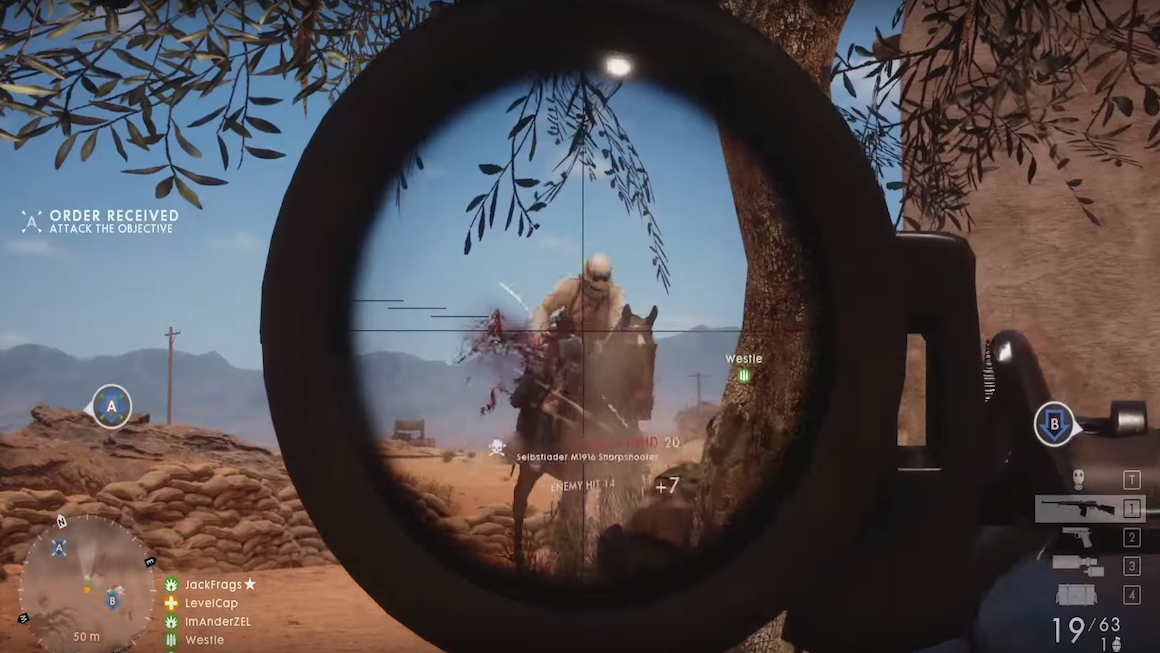Platforms:
Xbox One, PS4, PC
Released:
October 21, 2016
Publisher:
Electronic Arts
Developer:
EA DICE
“What follows is frontline combat. You are not expected to survive.”
The opening line of the single player campaign is less a warning than a promise. As the on-screen instructions teach you how to fire a gun, you can’t help but imagine how awful it would have been to be a real combatant in World War 1. You have never fired a gun at another person, you have very little combat training, and the only thing standing between you and the enemies that are now storming towards you is the half-blown up wall of a building standing atop a pile of rubble.

Fending off the first few enemies, you are continually screamed at by your commanding officer to “hold”, which for now, you are managing to do. But when the flame troopers start to scramble over the fences and the air around you is engulfed in white-hot fire, you realise the outcome was inevitable. But now you are in a different place further up the front, in a different body too, manning the gun in a British tank. You are making good ground as you push further into enemy territory; until the artillery shelling lands and everything begins to fade to black.
This is how the opening campaign continues, piecing together a handful of stories that were never told until you have a clear picture of exactly how bleak World War 1 really was. Battlefield 1 developer DICE has set out to deliver across four key areas which it believes makes Battlefield a unique franchise: All-out War on an epic-scale, Immersion, Strategy and Destruction.

The War Stories mode, which is made up of six individual campaigns including the prologue, is definitely designed to immerse you not only into the history of the war, but into the game itself. You’ll find yourself in a variety of different situations: an ex-chauffeur who has been co-opted into becoming a tank driver for the British army; an Italian mountaineering troop who wears full body armour as he makes his way across the snowy Alps; an Anzac soldier who has to deliver vital messages along the beaches of Gallipoli. You even get to play as Lawrence of Arabia!

Not only are these short stories individually well-developed, deftly exploring themes of fear, cowardice, bravery, teamwork and sacrifice, but they also serve as a training ground for the player. You will learn to pilot a plane, drive a tank and ride a horse alongside the protagonist. As such it is recommended to complete all of the War Stories before you enter the fray of Multiplayer.
What really makes these stories immersive, over and above the emotional plot-lines, is the pure and simple beauty of this game. Battlefield 1 is probably the best-looking first-person shooter released to date. Whether it be the intensity of the desert sun burning down upon you; the murkiness of the muddy forest floor, or the still darkness of a French village before the break of dawn, you will feel like you are in the game in a way that is totally breathtaking.
But most people won’t even be picking up this game for the War Stories. The success of Battlefield 1 was always going to rest on the quality of the multiplayer experience. This is where the focus on strategy and all-out war on an epic scale really come to the fore.

Players of previous iterations of Battlefield (or any first-person shooters really) will recognise several of the game modes, including Conquest, Domination, Deathmatch and Rush. All of these game modes have their merits, but instead, I’m going to focus on an entirely new mode called Operations. Operations is really an amalgamation of some of the other modes, where the battlefield can extend across multiple maps and objectives in a multiplayer experience that can last well over an hour.
“Strategy and teamwork are essential to success in absolutely enormous environments”
Strategy and teamwork are essential to success in absolutely enormous environments, with up to 64 players running around the battlefield. What I like is that multiple different play-styles outside of your standard ‘run and gun’ can be effective. To that end, each of the four classes feel meaningful and important, whether it be healing and reviving as a medic, ammo resupply as a support, the close-quarters firepower of the assault or the long-range power of the scout.
If I had to comment on the current metagame, I would be tempted to say that the Scout is probably emerging at the top of the pile at the moment. This is due to the inherent advantages of playing a long-range class on such massive battlefields. It is very difficult to seek out and surprise a scout before they have an opportunity to take you down first. Even with this advantage however, it never feels too overpowered due to the variety of maps available: there are several maps where scouts can’t be very successful due to heavy cover.
Positive:
- Beautiful visuals
- Emotional single player
- Multiplayer mayhem
Negative:
- Menu interface not as intuitive as it could be
- Steep learning curve
- Expensive to opt in to DLC
Destruction, the final pillar of Battlefield 1’s game design, is clearly evident in all game modes. Interestingly, it’s not only a physical and emotional presence in Battlefield, but also a strategic one. You’ll find that almost all parts of the environment have destructible elements which open an array of new combat mechanics, whether it be reducing your enemy’s cover with repeated gunfire or simply steam-rolling them in a tank.
Battlefield 1 is not for the faint-hearted: there is no coddling in multiplayer and don’t be surprised if you don’t get a single kill in your first few games. But if you’re up to the challenge, there is a visually-arresting, strategically nuanced and extremely fun game waiting for you in Battlefield 1.








